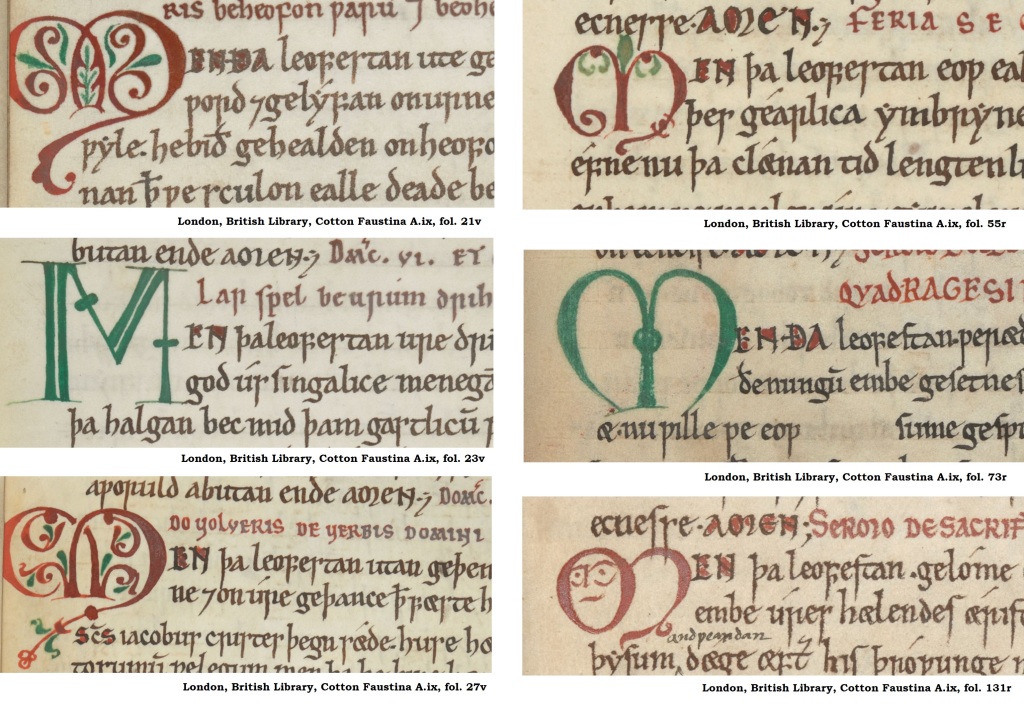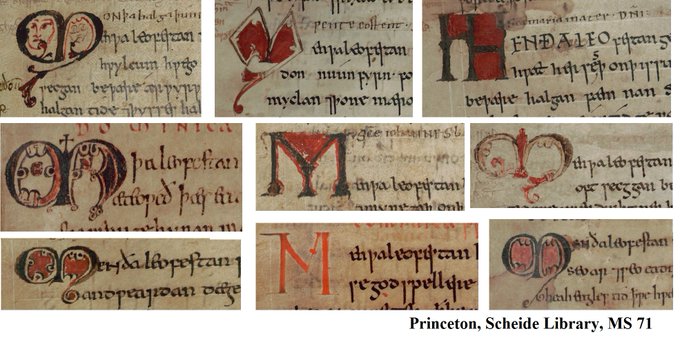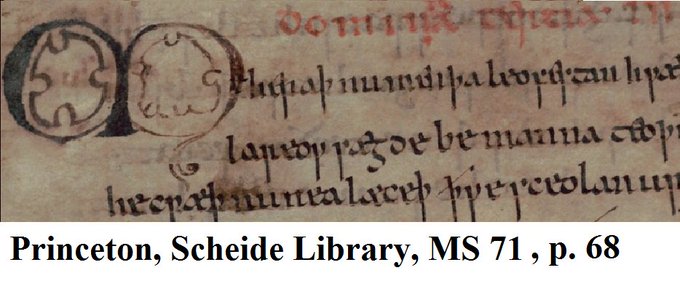“Men þa leofestan!” “Men ða leofestan!” “Men þa leofestan!” This blog post deals with the ways in which a very common Old English phrase was differentiated by early medieval English scribes.
Men þa leofestan! An opening formula of many Old English homilies
If you were to go to church in early medieval England, it is very likely that you would hear the words “Men þa leofestan!” [Dearest people!]. The phrase is found more than 200 times in Old English homilies. In fact, it was the most common way for priests to start their sermons. This is reflected in various medieval manuscripts which feature embellished versions of the phrase to indicate where a new homily began. But if several homilies in the same manuscript started with the same phrase, how would you be able to tell these homilies apart?
Intriguingly, scribes appear to have been aware of this potential difficulty and, as a result, they show a striking variability when it comes to decorating this initial Old English formula. A case in point are the six homilies that start with this phrase in the following 12th-century manuscript:

Each phrase is uniquely handled. The initial M’s, for instance, are all clearly different: some are fully green, others are red with green foliage-like decorations, while the last M is fully red and has a quirky little face. Aside from the different initials, the capitalisation of the rest of the phrase also differs: some capitalise the full first word (MEN), while others capitalize the second word as well (MEN ÐA).
More dramatic variation is found in the various Old English homilies of the late tenth-century Vercelli Book that start with the phrase “Men þa leofestan”:

Here too the scribe differentiates in what parts of the phrase are written in capitals: MEN ÐA LEOFESTAN; MEN ÐA; MEN ÐA LEO; MEN; MEN; MENN Ð(A). The two homilies that start with the lavishly decorated initial M (complete with monstrous head in the middle and little hand? on the left) are strikingly differentiated from the others, while the last of the six homilies (bottom right) uniquely appears to feature two capital M’s and an E that were erased (possibly to leave room for a larger decoration that was never added) – the scribe also seems to have miscalulated how much space was left on the page as he had to add the A inside the Ð to form the word ÐA.
In these ways, the scribes of Cotton Faustina A.ix and the Vercelli Book clearly differentiated between homilies that started in exactly the same way: “Men þa leofestan”.
“Men þa leofestan” in the margins of the Old English Bede
Even when homilies were added to the margins of a manuscript, attempts appear to have been made to differentiate between those homilies that had the same opening formula. This much becomes clear from a manuscript of the Old English translation of Bede’s Ecclesiastical History of the English People.

This particular manuscript of the Old English Bede is well-known for its marginalia, which include remedies against sore ears, sore eyes and stomach sickness and a magical SATOR square. No fewer than six homilies were added to the margins and four of them start with the well-known phrase “Men þa leofestan”:

Each homily starts with the same phrase, but they clearly have different capitals. Note how the second homily (bottom left) simply writes “Men ð. l.” – the scribe clearly assumed that his reader was familiar with the phrase!
One “M” too many: “Men þa leofestan” in the Blickling Homilies
Another manuscript with many instances of the initial formula “Men þa leofestan” is the tenth/eleventh-century ‘Blickling Homilies’. Whoever was responsible for the illustrated initials in this manuscript appears to have made a great effort to make different kinds of M’s:

Every capital M here is unique! Unfortunately, our Anglo-Saxon M-artist appears to have been a little overzealous in this manuscript, as he accidentally introduced an M where it should not have been:

“M heraþ nu men þa leofestan!” [M hear now, dearest people]. This homily appears to have deviated from the standard pattern of the ‘Blickling Homilies’ by first introducing the verb “heraþ” (or possibly “geheraþ” – you can see a trace of the e in the M), but the scribe was so used to writing variations of the capital M that he added one there by default. Oops!
Men þa leofestan! I hope you have enjoyed this blog post; if you did, please consider subscribing for regular blog updates and/or read the following blog posts:

I’m reminded that to this day Russians often start an address to the public with “Dear Friends,” in a manner that implies to all listening, “come share this with me.”
LikeLike